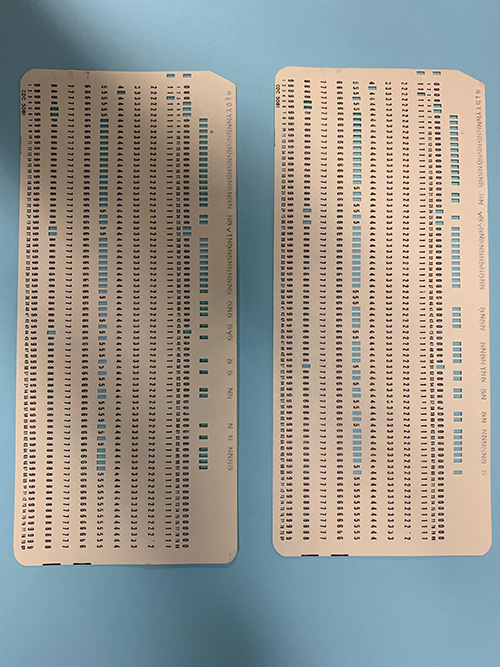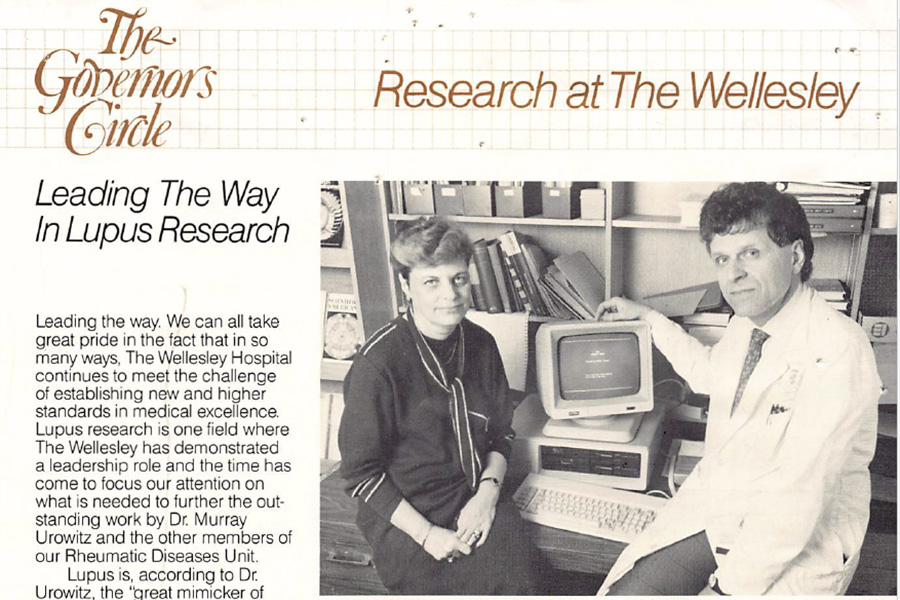Liz Attfield and her daughter, Molly, in 2019. (Photo: Tim Fraser)
Liz Attfield was a teenager when she was first diagnosed with lupus, a chronic autoimmune disease which affects the organs, joints and skin.
More than 50,000 Canadians and five million people worldwide are living with lupus.
For Liz, a lupus diagnosis was challenging enough. But her next biggest worry was whether she’d be able to have a baby, something she had always dreamed of.
“I really thought it might never happen for me – and I couldn’t accept that,” she says.
Under the care of Dr. Murray Urowitz, a clinician-researcher and the founder of the Schroeder Arthritis Institute’s Lupus Clinic at UHN, Liz started the journey toward motherhood.
“He was this smiling bear of a man,” Liz recalls. “I was so distraught, but he said, ‘You can do this. You can manage this.’ And I believed him.”
Today, Liz’s daughter, Molly, is 11 years old and thriving. Her smiling baby photo joins dozens of others adorning a wall in the clinic – a testament to the women Dr. Urowitz and the clinicians, nurses and staff have helped over the years.
“Just 20 years ago, women with lupus were advised against pregnancy due to the increased risks to their health,” says Dr. Urowitz. “Today, it’s still considered high risk, but for many patients, their pregnancy can be managed through medication and monitoring.
“There is no better feeling than making a wish come true.”

Much like the Lupus Clinic, which is celebrating its 50th anniversary this year, Dr. Urowitz – the brains and heart behind the original clinic – is considered a pioneer in the field.
“I became interested in lupus back when I was still a resident,” he recalls. “That curiosity only grew as a young rheumatologist.
“Clinically, lupus is an incredibly complex disease impacting nearly every organ in the body. Ten patients with lupus can have 10 completely different sets of symptoms and presentations,” says Dr. Urowitz, adding that there were very few physicians treating lupus patients 50 years ago, and virtually no lupus-focused research happening in Canada.
“People were suffering and I wanted to help them,” he says.
In 1972, Dr. Urowitz started the University of Toronto Lupus Clinic at the former Wellesley Hospital. Then, in 1995, he joined forces with renowned rheumatologist Dr. Dafna Gladman and moved the clinic to Toronto Western Hospital.
One of the truly innovative things about the clinic’s beginnings was Dr. Urowitz’s laser focus on the importance of collecting data from the patients they treated.
“We started with charts on a giant wall to help us identify and analyze different subsets of patients,” Dr. Urowitz recalls.
“Then, we moved to these massive computers at the University of Toronto and used punch cards to analyze the data. Now we do it on a laptop!” he laughs.
“I remember thinking back then, if we are going to make any impact on this disease, we need to understand the progression of disease in our patients and follow it over time.”
Today, the Lupus Clinic’s data bank – the largest and most comprehensive in North America, and one of the largest in the world – has tracked the disease progression of more than 2,000 patients and 70,000 patient visits.
“You hear about artificial intelligence, well that’s what we were doing back then – feeding in huge amounts of data and asking the computer to analyze that data,” says Dr. Urowitz. “Each time the number of patients went up, we had the opportunity to make additional discoveries.”

One of those discoveries included looking at the benefits and the potential side effects of prevalent therapeutics such as hydroxychloroquin.
“We were able to show that, yes, hydroxychloroquin is very effective for many lupus patients, preventing further damage, but there are also side effects that were not previously associated with the medication,” says Dr. Urowitz.
One of the most profound discoveries was around heart toxicity issues connected to lupus.
“We were able to show that that there were certain predictors of who might experience these cardiac issues,” says Dr. Urowitz. “Knowing this, we could treat these patients with a more customized approach.”
Honey Agar, 82, was one of Dr. Urowitz’s first lupus patients at the clinic and the first patient to be enrolled in the cardiac research study.
“There isn’t a part of my body that lupus didn’t touch over the years,” she says. “It’s been a long road. But, Dr. Urowitz always advocated for me and that inspired me to help others.”
Honey turned her pain into action, founding Lupus Ontario, and then Lupus Canada to help advocate for patients like herself. Dr. Urowitz was regularly called upon as a speaker at local and national events.
“He never said no,” says Honey.
Fifty years later, she’s a devoted supporter of Dr. Urowitz, and also his number one fan.
“Dr. Urowitz always was, and still is, very forward thinking,” says Honey. “He is a great problem solver and diagnostician, and he is beloved by his patients and students.
“Most importantly, he is always willing to listen.”
Today, in large part due to support from patients such as Honey Agar, as well as funding and advocacy organizations, lupus has evolved into a chronic condition, rather than a lethal one.
“When I started treating lupus patients, the five-year survival rate was 50 per cent,” Dr. Urowitz says. “Today, the 20-year survival rate is approaching 90 per cent.”

Dr. Urowitz notes that he is “very proud” of his role as a leader in lupus care, research and innovation. He has trained more than 140 post graduate rheumatology fellows, with a regular roster of invitations to speak around the world, and has more than 450 publications to his name.
But his greatest accomplishment may be his contributions to research.
Having shown that patients with lupus develop premature atherosclerosis and heart attacks at a young age, Dr. Urowitz set out to investigate why. The research indicated that both the classic cardiac risk factors and persistently active lupus disease combined to bring this about.
“We have now shown that if we can control hypertension, cholesterol levels, smoking and diabetes, as well as heart issues, many people can live a longer, fuller, healthier life,” says Dr. Urowitz.
“We’re learning more about the different immune pathways that are abnormal in lupus and we’ve found ways to interrupt this process. This is what is going to lead us to new treatments.
“I am so proud of what we have accomplished in the last 50 years and I look forward to the advances that have yet to come.”
Dr. Urowitz’s legacy will continue with the establishment of a Professorship in Lupus Research at the University of Toronto, in his name.
And thanks to the mentorship by him and Dr. Gladman, the lupus program continues to cultivate a new generation of specialists, including Dr. Zahi Touma, a rheumatologist, who joined the clinic as a trainee in 2007 and became a clinician scientist in 2014.
Dr. Touma’s work focuses on the cause of neuropsychiatric lupus and particularly on cognitive dysfunction or “brain fog,” which affects more than half of lupus patients.
“Dr. Urowitz and Dr. Gladman really set the stage for lupus research to flourish in Canada,” says Dr. Touma. “I’m honoured to be carrying the torch forward to make new discoveries and improve the quality of life for lupus patients.”
Liz Attfield says Dr. Urowitz is “so kind, patient and thoughtful in his approach.
“We are so lucky to have such a champion as him.”
For patients such as her and Honey Agar, who credit Dr. Urowitz’s fearless optimism and dogged determination for their excellent care and for advances in lupus research over the years, the relationship between doctor and patient can be a decades-long one, often reaching further than the clinic.
“Over the years, I’ve been invited to christenings, graduations, weddings,” says Dr. Urowitz.
“For me, there is no greater joy than helping my patients.”


